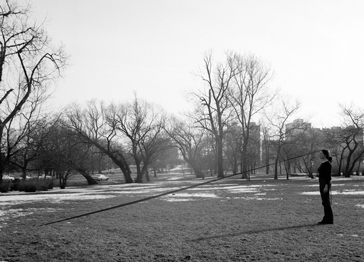
Born in 1943 in Barcelone (ES). Lives and works in Barcelone (ES).

1973
5 Black & white digital files,high resolution, bright printing.
Year of Purchase: 2012
In 2011, the Barcelona Museum of Contemporary Art (MACBA) held its first monographic and retrospective exhibition devoted to the Catalan artist Àngels Ribé. En el laberint—Ángels Ribé, 1969–1984 1 allows the viewers to discover the sculptural, participatory, performative, and photographic work of this little-known artist, and situate it in the context of the conceptual and performative scene of the 1970s. In 1967, Àngels Ribé left Franco’s Spain for Paris where she studied sociology. It was there that, as a member of Piotr Kowalski’s sculpture workshop, she created her first sculptures and interventions in public spaces.
1969 was a pivotal year for Àngels Ribé. She produced a series of works which foreshadowed her future productions: Acciò al parc (“Action in a park”) and Laberint (“Labyrinth”) are mobile, supple, ephemeral sculptures made with modest (long panes of yellow plastic in Laberint) or functional materials (an airplane air duct in Acciò al parc), which engage the audience’s bodies and participation. Each work can be modified through the possible interactions between the viewers and the space, whether open or enclosed, where it is placed.
In the early 1970s, A. Ribé (the artist had decided to erase her gendered first name) moved to Chicago, then to New York, and participated in the experimental effervescence of a generation of artists who had broken with the modernist conception of the unity and materiality of the work of art and with the art market, and instead were “producing” themselves in galleries and alternative locations 2. In her ephemeral interventions, actions (outside the presence of an audience) and public performances, Àngels Ribé constructs a gesture that is provisional and scripted, fragile and political, where the bodies of the artist and of the viewer are central. She produces actions and performances in which the use of everyday, utilitarian, or natural objects or materials (such as wind, foam, light, shadow…) in anachronistic contexts unlocks the visible in the impalpable part of perception and makes the most miniscule, invisible part of phenomena show through.
Àngels Ribé conceived numerous actions which restore both a mental and a sensitive space to sensory perception. In her series 3 Points (1, 2, 3), to which belongs 3 Point 4, Chicago (1973–2013), the artist shows a geometric line through a fixed position or through the movement of her body, which forms one or a succession of triangles. In the action 3 Point 4, the displacement of Ribé’s body under a line, which is made material by black Scotch tape resting on her head, sketches a triangular shape that appears and disappears in order to be formed anew, through the interaction between three necessary “elements” which are Ribé’s body, the ground, and that flexible tape. The artist geometrizes the world and shows it at a human scale.
Showing space and the idea of space through action or performance, as in Constatation de la présence d’un volume immatériel (1974), makes the artist engage in a dialectic of presence and absence, of fullness and emptiness. Here, an electric fan suddenly produces an artificial breeze that mingles with the ambient air, causing the audience to step back, and opening up a view of what could be an empty space. Elsewhere, with the spatial installation North-South-East-West (1973–2013), it is cartography and the use of cardinal directions that reveal a space both real and imagined.
All of Àngels Ribé’s work is located within this language of tension between fragility and disorientation, perception and sensation, being attuned to reality and its phenomenological possibility.
Marjorie Micucci
1 Exhibition En el laberint—In the Labyrinth, Àngels Ribé 1969–1984, curated by Teresa Grandas, took place between July 15 and October 23, 2011.
2 In her text, The Poetics of Resistance, written for the exhibition catalog En el laberint, Teresa Grandas emphasized how often performances and actions photographed by Àngels Ribé were shown in the “hotspots” of the alternative art scene, in New York as well as in Chicago or Montréal: at the N.A.M.E. Gallery in Chicago, or at Vehicule Art Gallery in Montreal; or at Store Gallery in New York, at 3 Mercer Street.